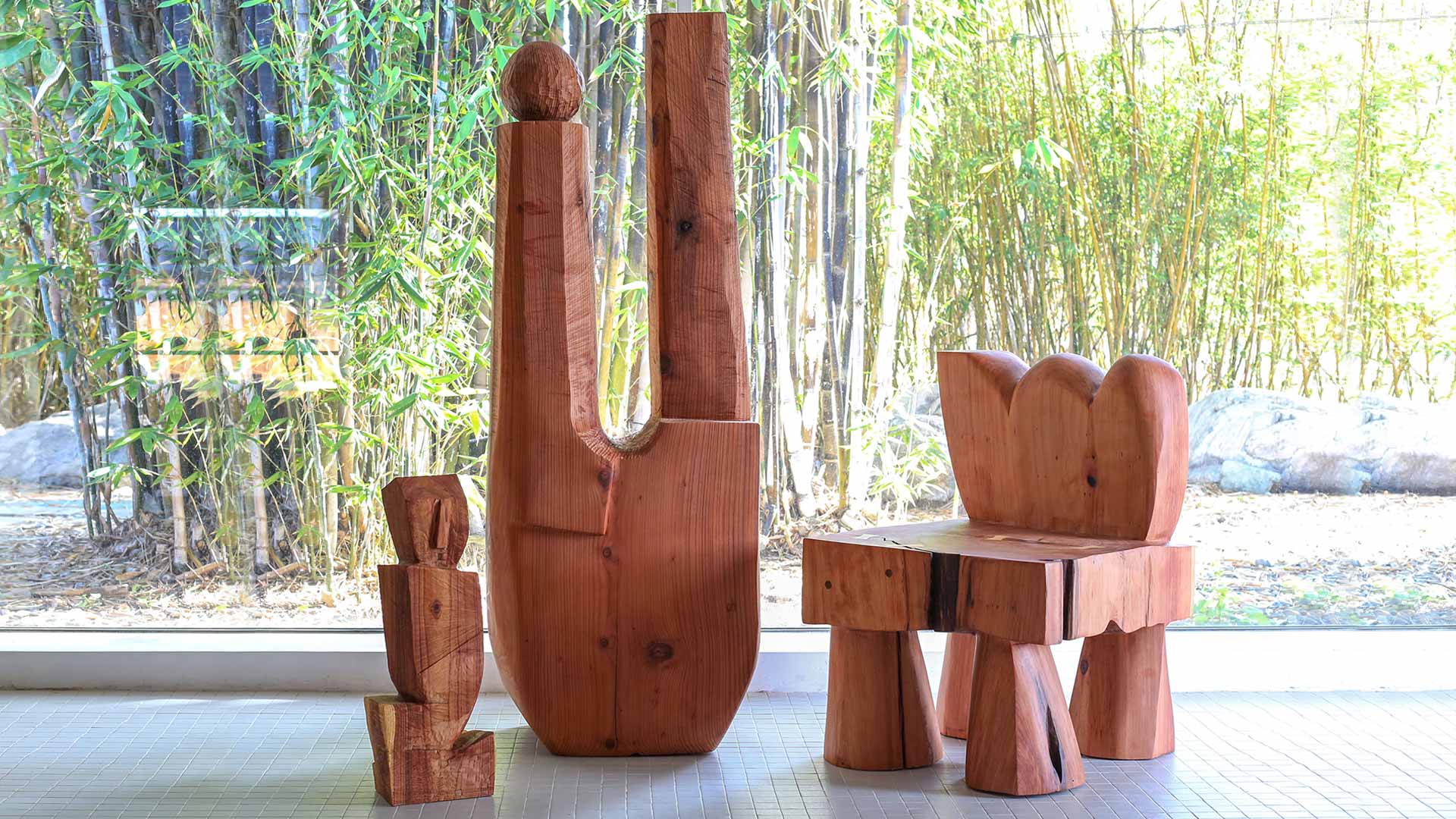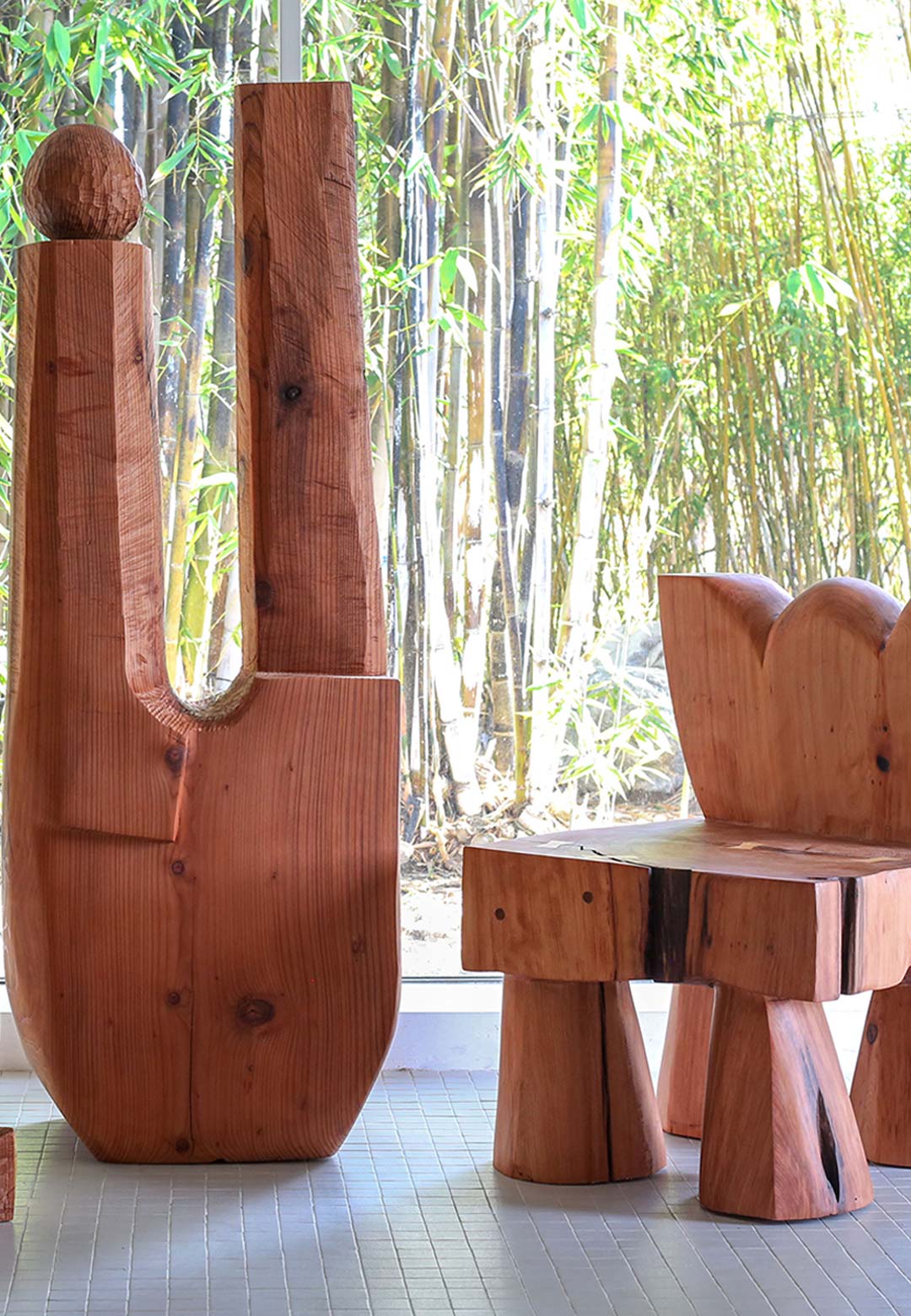History attests that the importance of trees transcends physical and material dimensions. Traversing the globe and permeating diverse cultures, forests were ascribed an array of symbolic functions and values. For humankind, trees have long been the link between the earth and the sky, the human and the divine—a fundamental force of life that feeds our bodies and spirits, alike. Although, over the span of centuries, these almost umbilical ties slackened or were severed, the sentiment of solace that one encounters in nature perseveres. With treasure troves of knowledge, spirituality, and numerous whispered wishes and thoughts, what happens when these beings fall victim to another force of nature? Do these conversations end?
With over 25,000 city-owned trees, Claremont prides itself on the title it enjoys: the city of trees. In this suburban city, where dense canopies and abounding foliage form its fabric, California-based furniture maker and sculptor Vince Skelly unveils a show of his new works at the Claremont Lewis Museum of Art. A tribute to his hometown, A Conversation with Trees marks Skelly’s first solo museum exhibition, following his successful representation with acclaimed galleries. In the exhibition on display from February 17 to April 23, 2023, , the American artist carves tree trunks—many harvested in the aftermath of the epic wind storm of January 2022—and with each chip and groove, explores the space between sculptural form and functional object. The show will include seven new pieces including chairs, side tables, stools, totems, and both small-and-large scale monolithic sculptures intended for outdoor installation. "I have fond childhood memories of playing outside on Claremont's public art sculptures; they are dear to my heart. Now that I’m back living and working in my hometown it makes me happy to contribute to that legacy,” says Skelly.
Born in Claremont, Skelly was raised in a family of artists and recently returned to live and work in his hometown. Early days of his sculpting career involved learning how to command his primary tool: a chainsaw. Through an experimental journey of turning found logs into simple geometric shapes, his creative philosophies crystallised into a more methodical approach—influences conspicuous in his work, currently on view. A constant pursuit of the relationship between the past, present and future, fuels Skelly’s sculptural art. Akin to how prehistoric carvings and tools assert a certain relevance in the modern world, the artist interrogates concealed ties between ancient structures and modern architecture and furniture design. Through works meticulously carved from a single block of wood, Skelly enunciates his belief in an amorphous relationship between the contemporary and the prehistoric, culminating in an array of unified objects. “I tend to turn to megalithic structures for inspiration, including stone Dolmen structures which are, of course, ancient but at the same time feel almost modern in their clean lines, minimalist shapes, and construction by way of natural materials,” explains the furniture designer.
When approached by the museum's art gallery—a facility spotlighting painting, sculpture and other works by local artists—his eagerness to partake was imminent, owing to his fond childhood memories. Seven new functional and sculptural forms made out of local and sustainably sourced wood take the stage in the solo exhibition. Five of the new creations are sculpted from local trees, including magnolia, redwood, Brazilian pepper, and pine, that was struck by the fatal windstorm. This aspect highlights how acquiring wood from sustainable sources is an intrinsic component of Skelly’s process. As the storm offered an abundant supply of wood, a surprising opportunity came to life—an opportunity to positively harness incredible destruction and loss.
This propensity towards off-cuts and his perception of waste speaks of an important influence on his work, the American sculptor JB Blunk. "What inspired me the most about Blunk's sculptures was that he worked with found material that was collected around where he lived,” explains Skelly. “It made me want to learn how to see what he saw in a dirty, wet, unassuming piece of wood. Because of this, I still go out to collect random logs on the side of the road, or off-cuts from arborists when I see them cutting down a tree," he adds.
Process, collective memory, and material amalgamate as Skelly reductively carves each stool design, chair design, or abstract form. Tracing the contours of grain, patterns and knots, inherent to the material, he achieves fundamental forms that are forged by the singularity of each block. His raw and minimal approach allows for the life of the tree to be the protagonist in the composition and shine through in its imperfect splendour. Natural forms join forces with the weight of ancient stone dolmens, and by infusing this blend with the visual potency of mid-century modern architecture, timeless and idiosyncratic silhouettes are born. Underpinned by his background in graphic design, a deep understanding of typography, the power of a bold silhouette and the value of restraint reflects in his monoliths—showcasing a tension between twisting natural forms and a distinctively human captivation with geometric shapes.
Various threads converge and intertwine to give fruition to Skelly’s oeuvre—both ancient and modern traditions of wood carving, divergent reference points from megalithic dolmens to the sculptures of Brancusi and the figures animating the paintings of Philip Guston. As he manoeuvres his chainsaw around rescued chunks of wood, Skelly reveals biomorphic volumes, and carved portals, each exuding an imitable spirit and personality. Some pieces are evidently for sitting upon, while others are for imaginative interaction, the work fluidly melts the boundary between form and function. Yet essentially, the ensemble is not about the forms at all; rather it is about the essence of the project. The sculptures poetically pay homage to Claremont, silently recalling the storm and the trees it uprooted, and is a subtle reminder of the advancing climate change and the associated natural disasters that wafts in the exhibition space. As one treads through and around this conjunction of different worlds, the domineering yet somewhat vulnerable sculptures facilitate a relationship with the audience, one that is vivifying and teeming with surprises.
A Conversation with Trees will be on view from February 17 to April 23, 2023, at the Claremont Lewis Museum of Art in Claremont, California.






 Sign in with email
Sign in with email










What do you think?